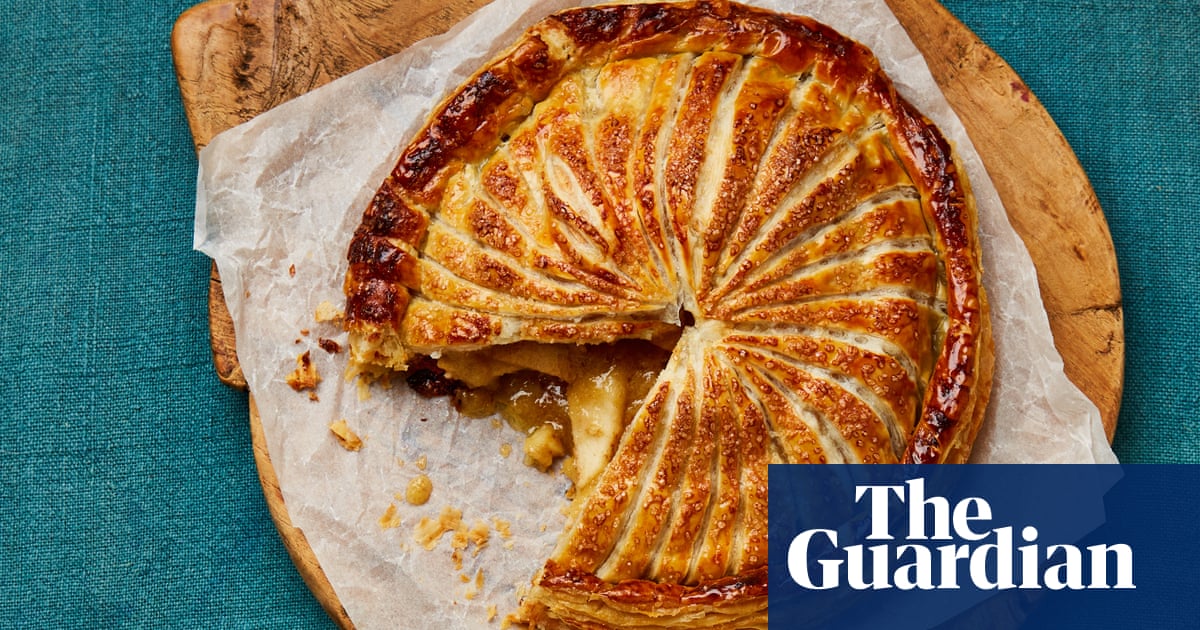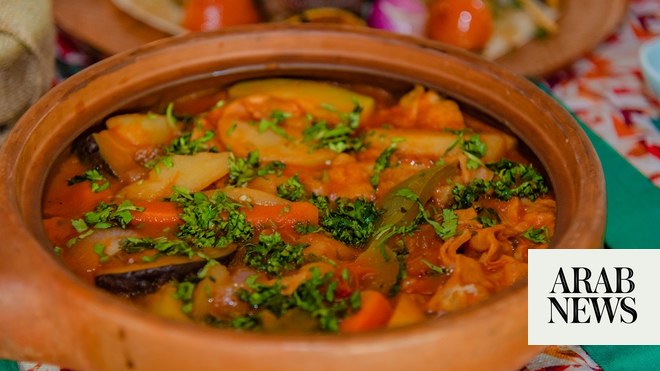
Wild mushroom, leek, chestnut and stilton filo pie
Prep 45 min
Cook 30 min
Rest 20 min
Serves 6
Olive oil (or cooking oil of choice)
Melted butter, for greasing and/or brushing the pastry (optional)
3 leeks, roughly chopped
Salt and white or black pepper
300g mixed wild mushrooms (girolles, porcini, chanterelles, ceps, etc) or chestnut or portobello mushrooms, plus a few soaked dried porcini, roughly chopped
300g roasted and peeled chestnuts, roughly chopped
A few fresh thyme sprigs, leaves picked – save the stalks for the pumpkin side below
1 big glass white wine
250g ricotta
300g stilton, crumbled
Nutmeg, for grating
6 sheets ready-made filo pastry
Poppy, sesame, fennel and/or caraway seeds, to garnish
Honey, for drizzling (optional)
Heat the oven to 200C (180C fan)/gas 6. Grease a 22cm round cake tin (with a detachable ring, ideally) with oil or a good layer of melted butter.
Warm three tablespoons of oil in a large saute pan over medium heat, add the leeks and a good pinch of salt, and cook, stirring, over a low-medium heat for 10-15 minutes, until soft and translucent. Remove from the pan, turn up the heat to medium-high, pour in two tablespoons of oil, then add the chopped mushrooms. Season generously with salt and saute for five to 10 minutes, until they’ve caramelised slightly, lost some of their excess liquid and shed their spongey rawness.
Stir the chestnuts and thyme into the mushroom pan, add the wine and crank up the heat to high for a minute or two, so the alcohol burns off. Stir in the cooked leeks (if the original saute pan isn’t quite tall enough, transfer everything to a taller saucepan, so you can mix the filling without it spilling out), followed by the ricotta, and stir to mix evenly. Add the stilton and a good dusting of nutmeg, stir and taste for seasoning: there should be a good balance between the flavours of the leeks, mushrooms, cheese and a little acidity from the wine. If it’s still quite savoury, add a spoonful of honey to round out the flavours, then season with your pepper of choice.
When you’re ready to bake the pie, gently take one filo sheet lightly brush the top with melted butter. Place it unbrushed side down in the cake tin, allowing the edges to drape over the sides. Repeat with the remaining filo, slightly turning the tin a few degrees after each addition, so the overhanging filo is neatly distributed.
Spoon in the cooked filling, fold over the filo overhang, brush with a little more oil or melted butter and, once the filling is covered, lightly scrunch the tips to create a frilly effect. Check that the pastry tips are all oiled, then scatter the seeds on top.
Bake for 30 minutes, or until crisp and golden. Leave to rest for 20 or so minutes, then unclip the tin and carefully lift the pie on to a serving plate.
To scale down If making for two to three people, use one sheet of filo per person and either make smaller pies, using a large muffin tin tray or small pastry tins, say, or simply place the filling in the middle of the pastry and fold over each layer, making sure to brush oil or melted butter on the exterior and base of the filo so it bakes to a crisp, golden finish.
Make-ahead tips Both the filling and the assembly of the filo pie can be done in advance, either earlier in the day or the night before, and kept in the fridge. The pie will be piping hot when you remove it from the oven, so assemble the other dishes while it rests.
Swede, pumpkin and sweet potato with saffron lemon yoghurt and pomegranate
This makes a great side for the filo pie main.
Prep 30 min
Cook 40 min
Serves 6
1 swede (400-500g)
1 small pumpkin (400-500g)
1 sweet potato (400-500g)
Olive oil, for roasting
Sea salt and black pepper
1 tsp cinnamon
1 small pomegranate
1 small pinch saffron strands
Zest and juice of ½ small unwaxed lemon
1 garlic clove, peeled and crushed
300g plain greek yoghurt
Clear honey, to taste (I use ½ tsp)
Heat the oven to 200C (180C fan)/390F/gas 6. Wash and peel the swede (I find swede skin a little unappetising, but leave it on if you prefer), then halve and deseed the pumpkin. Roughly chop the swede, pumpkin and sweet potato into 3-4cm chunks, then put them all in a large roasting tin with the thyme stalks reserved from the filo pie and drizzle with enough olive oil to coat everything lightly,. Season well, add the cinnamon and toss to coat.
Roast for 30-40 minutes, until the vegetables are softened and nicely burnished. In the meantime, shuck the pomegranate and set aside the seeds.
Next make the saffron lemon yoghurt. Put the saffron in a medium bowl with three tablespoons of boiling water, and leave to infuse and cool, stirring occasionally to release more colour from the strands. Stir in the yoghurt, lemon zest, a little lemon juice and the garlic. Season with a little sea salt, pepper and a small drizzle of clear honey, and set aside
To serve, transfer the roast vegetables to a platter, drizzle over the yoghurt and scatter with the pomegranate seeds.
To scale down If feeding two or three people, use just one or two vegetables, ideally including the sweet potato, to ensure the right balance of flavours. Keep any leftover pomegranate seeds for garnishing a pudding, or a salad of leftovers the next day. The yoghurt dressing keeps for a few days in the fridge and makes an excellent dip with crispbread or toasted pitta.
Make-ahead The yoghurt can be made a day ahead and refrigerated – just give it a good stir before serving. You can also shuck the pomegranate and keep the seeds in the fridge for a day or so.
Pickled beetroot with sprout, dried cherry and dill slaw (pictured top right)
Prep 10 min
Rest 3 hr +
Serves 6
For the pickle
150g caster sugar
300ml cider or white-wine vinegar
3 medium-large raw beetroot (about 300g in total)
For the slaw dressing
1 small bunch fresh dill
1 tsp grainy mustard
1 tsp horseradish sauce
1 tsp clear honey
Zest and juice of 1 small unwaxed lemon
3 tbsp neutral oil of choice
Salt and black pepper
For the slaw
300g brussels sprouts
1 handful dried cherries (or cranberries)
1 handful smoked and roasted almonds, lightly crushed
Put the sugar and vinegar in a medium saucepan on a medium heat, and cook, swirl a little to help dissolve the sugar. As soon as you have a clear solution and all the sugar has melted, turn off the heat and leave to cool.
If you prefer not to have purple hands, have some surgical or clean dishwashing gloves on standby for this next step: wash and peel the beetroot. Carefully slice them and place in the pickling solution - the thinner the slices, the faster the solution will penetrate, but if you prefer, simply cut them into eighths. Set aside while you prepare the sprout slaw.
Mix all the slaw dressing ingredients in a bowl, or blitz in a small food processor, then taste for seasoning – raw sprouts are quite bland, so need a punchy dressing.
Trim the sprouts, then slice as thinly as possible, then put in a large bowl. Tip in the dressing and toss until all the slivers of sprout are coated in dressing. Cover and leave for a few hours, so the flavour develops.
To serve, evenly scatter the pickled beetroot over a platter, top with the slaw and garnish with the dried fruit and crushed, smoked almonds.
To scale down For two three people, simply reduce the pickle by a third or half. The pickled beets keep for a few days in the fridge, so making the full amount will give you pickles to have in sandwiches; they also pair well with goat’s cheese or smoked fish.
Make-ahead Both the beetroot and the slaw can be made the day before or earlier on the day of celebration. Feel free to use other dried fruit such as apricots, figs, prunes or dates (or a mixture of them).
• For Signe Johansen’s roast duck with Jansson’s temptation and winter citrus salad, go here












